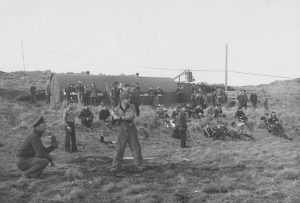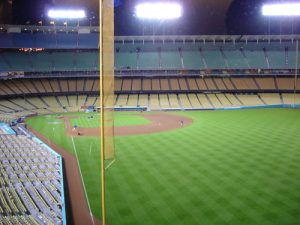19
Jake Brazinski
I really appreciate the historical perspective taken. Need to link to words/phrases like deliberative democracy. Outstanding personal statement. Need to fix the supplementary videos…aren’t open access.
Introduction
Times of war and global pandemics leave a lasting impact on economies and society as a whole. These impacts can transition into industries that initially seemed untouchable, such as professional baseball. Both World War II and COVID-19 brought a similar level of uncertainty about the future of baseball, but the way the games resumed differed.
Connection to STS Theory
The theory of deliberate democracy deals with the decision-making of topics foregoing “fair and reasonable discussion” that affect society as a whole. Leaders and officials gather together to make decisions in the best interests of citizens or those that may be affected. In WWII, the President and other leaders decided to have baseball leagues continue playing for the benefit of the citizens. They felt as though baseball would help with the mental health of those back home and keep them in a more positive mood with everything else going on in the world. During COVID-19, league officials and health experts decided to postpone baseball. They reasoned that it was unsafe for players, team faculty, and fans if the games were to continue. It was an unpopular decision that received backlash from both the fans and players, but they had the best interests of health and safety in mind. When the league officials and health experts decided it was safe for the games to resume and fans could return, they took extra precautions for the players and fans to social distance.
Baseball during World War II
WWII’s effect spread into industries that one might not originally think of, such as baseball. The President said that baseball must continue during the war because it was essential to society. Baseball was a source of entertainment, and most importantly, it provided an escape from the harsh realities that were happening in the world at the time.

This attracted large amounts of people to attend the games. Families and fans were eager to enter the stadiums to watch the game. Many major or minor league baseball players left the baseball diamond to serve in the war overseas (Bowen, 2020). As a result, sometimes, women joined the teams with fewer players to keep that team functioning and playing (LoProto et al., 2018). This evidence shows how there was no hesitation to keep baseball playing, even if it meant temporarily changing the dynamics of baseball.
Voices of Clemson Undergraduate Students
Since I was a kid, I watched as many St. Louis Cardinal baseball games as I could. I supported them whether they were good or bad, although at times it was hard to watch. When I found out the season was postponed and then shortened, I was shocked. My daily routine was affected; I found myself struggling to find things to do during the times I usually watched baseball. If me, a fan, was affected in this way, I could not imagine how the players were impacted. This led me to research just how much impact COVID-19 had on baseball.
COVID-19 and Baseball

COVID-19 impacted baseball at multiple levels and in a variety of ways. Spring training and the start of the MLB season were postponed, resulting in a much shorter season (ESPN, 2020). Some teams were exposed to COVID-19 and had to quarantine. As a result, those teams had to play multiple games in one day to make up for the games they missed while in quarantine. For college baseball, the season was cut short before the College World Series. Many college players were preparing for the MLB draft, but there was uncertainty about what would happen with everything going on. Additionally, younger players had to wonder if they lost a year of eligibility (Padron et al., 2020).
Comparing and Contrasting The Baseball Experience Between WWII and COVID-19
In some ways, baseball was affected the same way during WWII as it was during COVID-19, and in other ways, the impacts differed. During WWII, there was no delay to the start of the season, unlike during the COVID-19 pandemic. Also, fans were encouraged to go to the games during WWII. In contrast, the only fans allowed in the stadium during COVID-19 were virtual or cardboard cutouts. Towards the end of the season, a small number of fans were allowed in the stadium, but they had to social distance from one another. During both time periods, some of the players had to make sacrifices. These sacrifices may have been serving in the war, taking a pay cut, or donating money to support the faculty who worked at the stadium. This evidence shows how the resumption of baseball was a longer and more complicated process during COVID-19 than WWII because there was numerous protocol and guidelines the league had to follow.
Conclusion
Many people rely on baseball for employment or business, whether team staff, stadium faculty, local hotels, or restaurants. Baseball and sports, in general, are essential to society, which is why the leagues continue to play during times of war or a global pandemic.
Chapter Questions
- List some things leaders consider when making decisions in the best interest of the people
- Name one social change that started from a global event, like WWII or the Great Depression
Supplementary Materials
League of Their Own streaming on HBO Max
Sort the Court by Graebor – A decision making game
References
Bowen, Fred. “Perspective | During World War II, Baseball Players Wore Two Kinds of Uniforms.” The Washington Post, WP Company, 29 Apr. 2020, www.washingtonpost.com/lifestyle/kidspost/world-war-ii-affected-the-sports-world-but-baseball-games-didnt-stop/2020/04/29/e75022b6-805a-11ea-a3ee-13e1ae0a3571_story.html.
“List of Sporting Events Canceled Because of the Coronavirus.” ESPN, ESPN Internet Ventures, 23 Mar. 2020, www.espn.com/olympics/story/_/id/28824781/listsporting- events-canceled-coronavirus
LoProto, Mark, and Name *. “American Sports During World War II.” Visit Pearl Harbor, 28 Feb. 2018, visitpearlharbor.org/american-sports-during-world-war-ii/.
-, Kaylee Padron, et al. “Kaylee Padron.” South Florida Media Network, 19 Aug. 2020, sfmn.fiu.edu/how-covid-19-ended-college-baseball-in-2020/.
Images
Image 1: “WW2 Navy baseball (maybe Adak, Alaska) no date” by army.arch is licensed under CC BY 2.0
Image 2: “Empty Stadium” by Citoyen du Monde Inc is licensed under CC BY-NC 2.0
